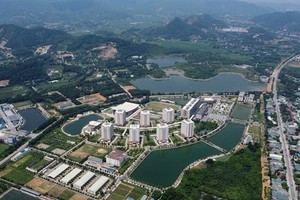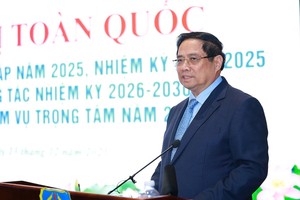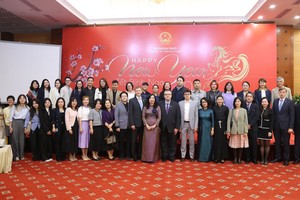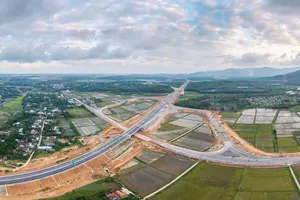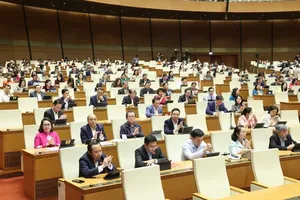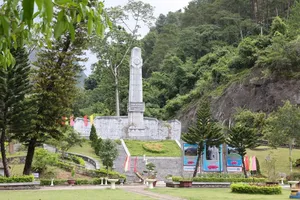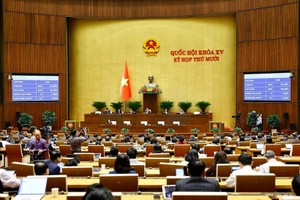
According to the HCMC Department of Natural Resources and Environment, the city generates an average of 9,800-10,000 tons of waste per day, around 70 percent of which is disposed of through sanitary landfills. However, observations in the vicinity of these landfills indicate that the landfilling process is negatively impacting the environment.
For instance, in Phuoc Hiep Landfill (Cu Chi District), severe pollution was observed in late July 2024, with black smoke plumes and a strong stench. Additionally, residents near the landfill have been affected by leachate from the landfill, contaminating water in nearby canals and emitting a foul odor.
More seriously, the leachate has seeped into the groundwater, affecting the lives of local residents. Unable to endure the pollution, many have been forced to sell their homes and relocate. The local authorities have repeatedly asked for feasible solutions, but the situation is not at all better.
Similarly, at Da Phuoc Landfill (Binh Chanh District), a strong odor was noticeable even at a distance of 30-50 meters from the landfill gate. According to local residents, while the odor has improved compared to the past, it still persists, especially during rainy weather.
Hanoi is also grappling with severe waste pollution. The city generates 6,500-7,000 tons of waste daily. Despite having two large-scale landfills, namely Nam Son (Soc Son District) and Xuan Son (Son Tay Town), pollution from waste remains a significant issue for residents.
In Hong Ky Commune of Soc Son District, residents have been enduring the foul odor from Nam Son Landfill for over 20 years. The dust and pollution from the constant traffic of garbage trucks have made daily life difficult for residents. The furniture inside their house has to be cleaned daily yet is still covered with dust. That is not to mention a large number of flies which annoy dwellers and pose a menace threat to their health.
Even with its vast area, Lam Dong Province only owns two solid waste treatment plants, both using outdated incineration technology. The waste treatment plant in Da Lat City emits a strong odor, negatively impacting the surrounding environment and agricultural productivity. Farmer Vo Duc Vinh, living in Xuan Truong Commune, annoyedly said that his coffee farm used to yield 15 tonnes per hectare before the operation of the plant. For the past two years, with the introduction of this plant, the farm output has been only 1-2 tonnes per hectare.
Phu Quoc City of Kien Giang Province is not a better case. With its growing tourism industry, the island generates 190 tonnes of waste per day. While efforts have been made to attract investors for a new waste treatment plant that can process 300 tonnes a day, progress has been slow. The island's existing landfill is overflowing, causing severe pollution. This ultimately harms the flow of tourists to the famous attraction, resulting in great loss to the local tourism sector.
Con Dao, often hailed as a pristine island paradise, has been struggling with a massive 70,000-tonne waste accumulation at Nhat Beach over the past 30 years. The island, which sees a growing number of tourists and residents, generates an average of 22.5 tonnes of daily waste, reaching 30 tonnes during peak seasons. While a 200-ton-per-day waste treatment plant was initiated in February 2022 to address this issue, it has yet to become operational. As a result, the island's pristine image is tarnished by the foul odors from the landfill during dry seasons and leachate during rainy seasons.
In a separate incident, the authorities in Binh Duong Province uncovered a massive illegal industrial waste dump in Tan Long Commune of Phu Giao District. The landfill, operated by Tra Vinh Environment One-member Co. Ltd., covered an area of 28,000 square meters and contained a variety of hazardous waste, including industrial chemicals, oil-contaminated packaging, and glass.
Despite regulations mandating the transportation and then disposal of such waste at a specialized facility in Tra Vinh Province, the perpetrators had illegally dumped the waste at this site. They purposedly constructed a 2-meter high fence surrounding the site to hide their illegal act.
Meanwhile, Phu Quy Island in Binh Thuan Province is grappling with its own waste management challenges. The island has accumulated over 140,000 tonnes of waste over the past 20 years. Although a project to construct a waste treatment plant over an area of 2.1ha was approved in February 2020, its implementation has been delayed due to land acquisition issues. As a result, the island's waste disposal capacity remains inadequate.
